Management and Operations Report: Tesco plc Analysis (Icon College)
VerifiedAdded on 2023/01/11
|18
|4786
|30
Report
AI Summary
This report provides a comprehensive analysis of Tesco plc's management and operations, addressing key aspects such as leadership roles, situational contexts, and operational approaches. The report begins by defining the roles and characteristics of managers and leaders, comparing their functions and highlighting their impact on organizational goals. It then explores the application of leadership in various situational contexts, including stable, slow-to-moderate changing, and fast-changing environments. Furthermore, the report delves into different leadership theories like situational leadership, system leadership, and contingency leadership, and how these theories apply to Tesco's operations. Finally, the report examines key approaches to operations management, including Six Sigma, queuing theory, and total quality management, and discusses the role of managers and leaders in implementing these approaches to enhance business efficiency and achieve organizational objectives. The report is based on the assignment brief provided by Icon College of Technology and Management for the BTEC HND in Business (RQF) Unit 4: Management and Operations.
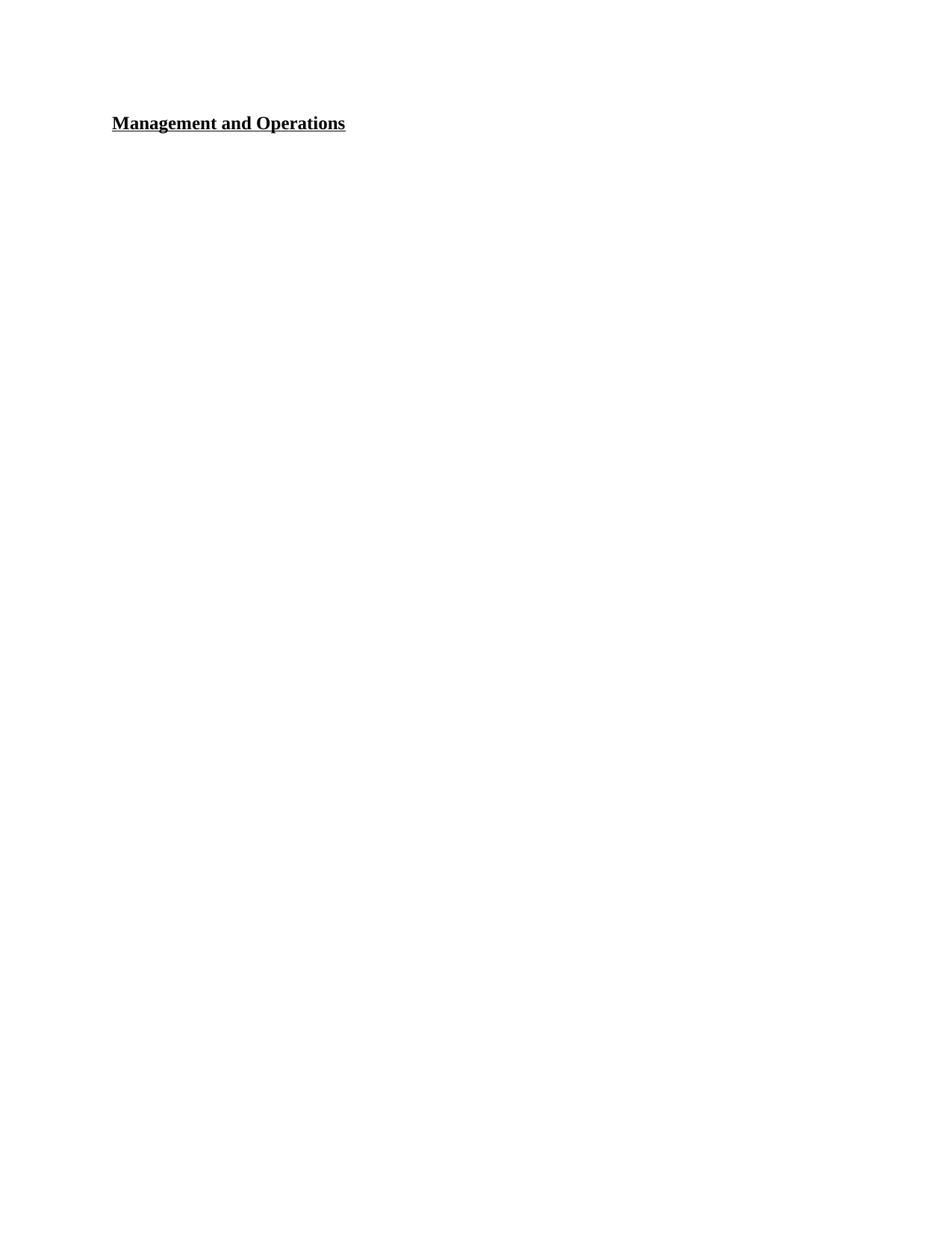
Management and Operations
Paraphrase This Document
Need a fresh take? Get an instant paraphrase of this document with our AI Paraphraser

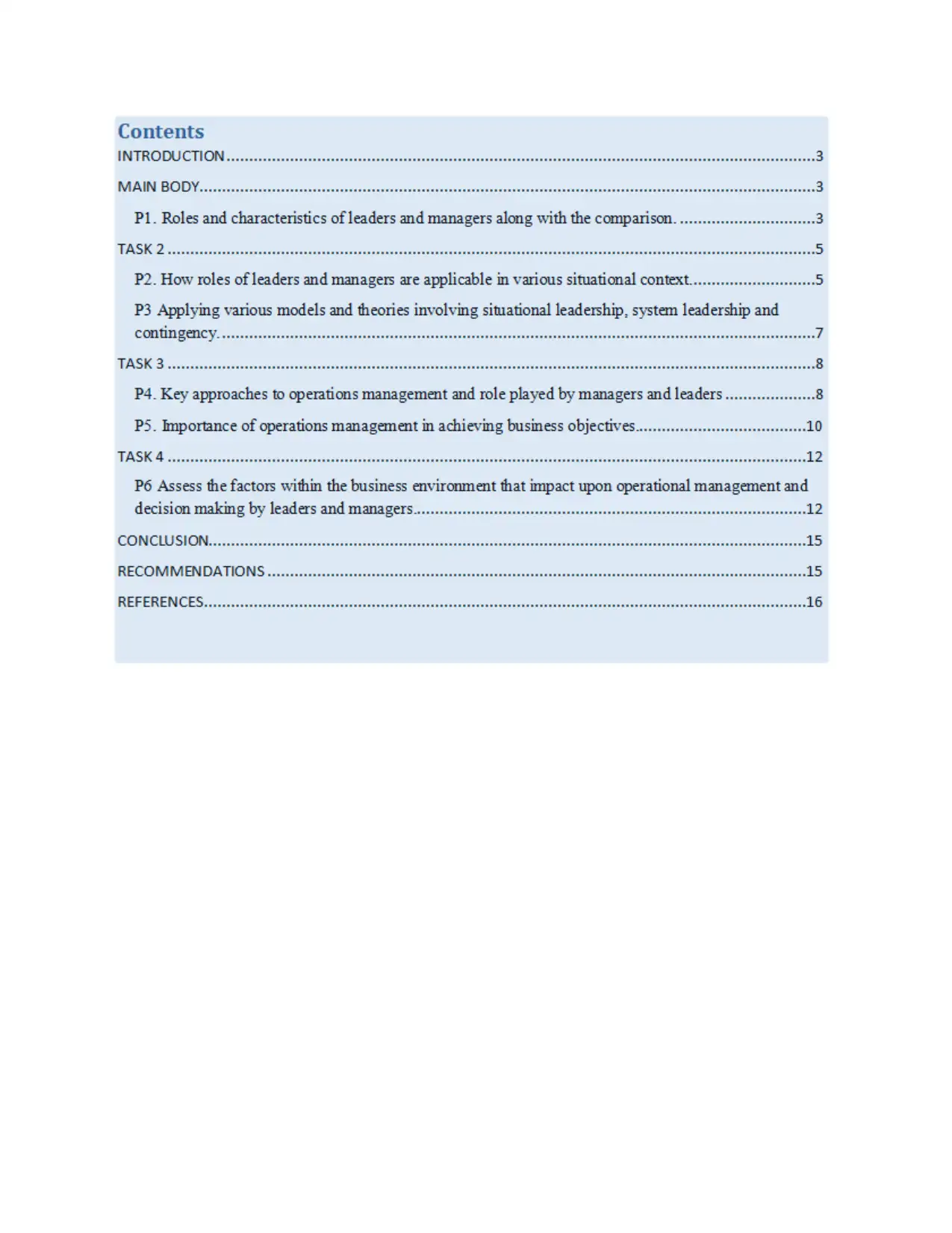
⊘ This is a preview!⊘
Do you want full access?
Subscribe today to unlock all pages.

Trusted by 1+ million students worldwide
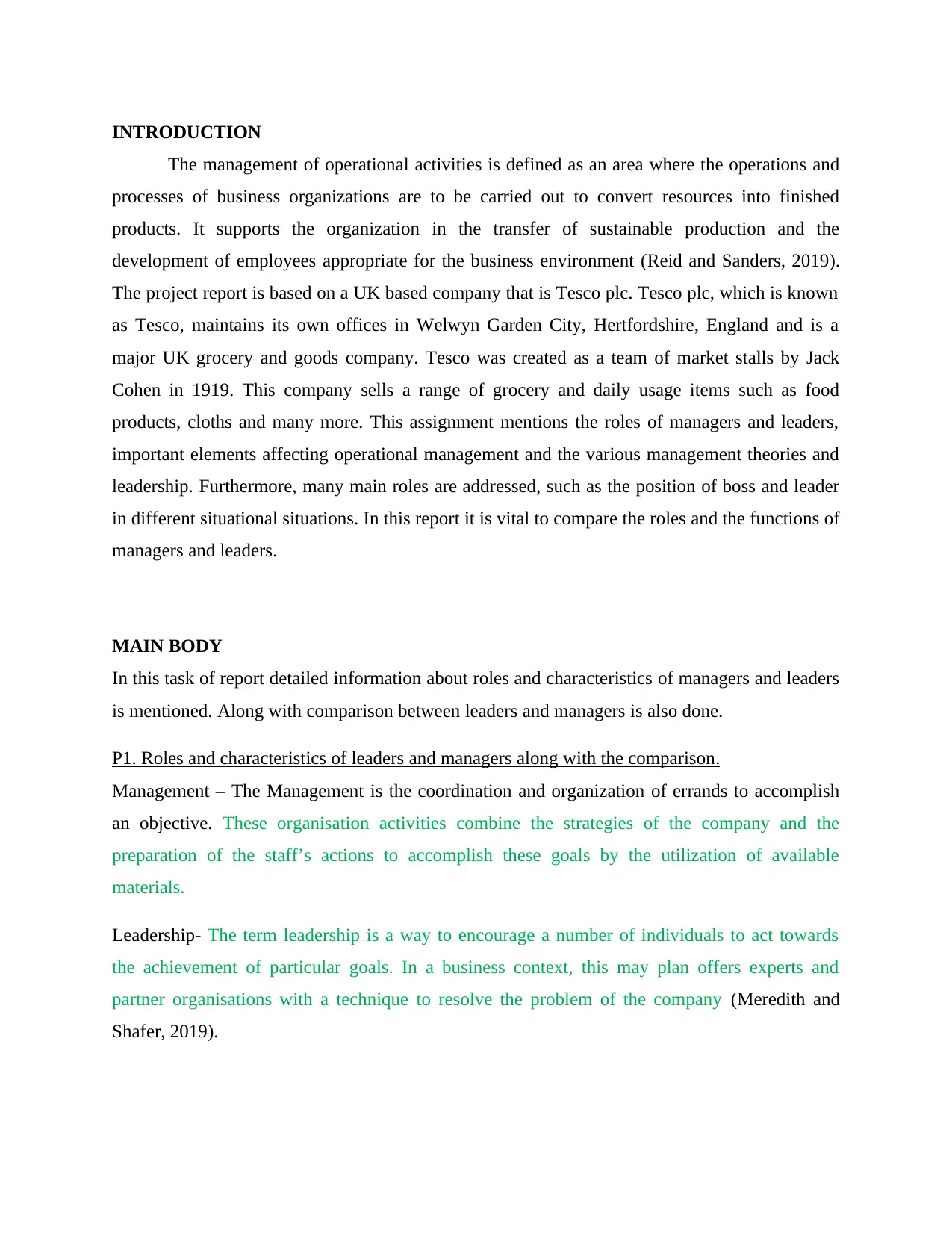
INTRODUCTION
The management of operational activities is defined as an area where the operations and
processes of business organizations are to be carried out to convert resources into finished
products. It supports the organization in the transfer of sustainable production and the
development of employees appropriate for the business environment (Reid and Sanders, 2019).
The project report is based on a UK based company that is Tesco plc. Tesco plc, which is known
as Tesco, maintains its own offices in Welwyn Garden City, Hertfordshire, England and is a
major UK grocery and goods company. Tesco was created as a team of market stalls by Jack
Cohen in 1919. This company sells a range of grocery and daily usage items such as food
products, cloths and many more. This assignment mentions the roles of managers and leaders,
important elements affecting operational management and the various management theories and
leadership. Furthermore, many main roles are addressed, such as the position of boss and leader
in different situational situations. In this report it is vital to compare the roles and the functions of
managers and leaders.
MAIN BODY
In this task of report detailed information about roles and characteristics of managers and leaders
is mentioned. Along with comparison between leaders and managers is also done.
P1. Roles and characteristics of leaders and managers along with the comparison.
Management – The Management is the coordination and organization of errands to accomplish
an objective. These organisation activities combine the strategies of the company and the
preparation of the staff’s actions to accomplish these goals by the utilization of available
materials.
Leadership- The term leadership is a way to encourage a number of individuals to act towards
the achievement of particular goals. In a business context, this may plan offers experts and
partner organisations with a technique to resolve the problem of the company (Meredith and
Shafer, 2019).
The management of operational activities is defined as an area where the operations and
processes of business organizations are to be carried out to convert resources into finished
products. It supports the organization in the transfer of sustainable production and the
development of employees appropriate for the business environment (Reid and Sanders, 2019).
The project report is based on a UK based company that is Tesco plc. Tesco plc, which is known
as Tesco, maintains its own offices in Welwyn Garden City, Hertfordshire, England and is a
major UK grocery and goods company. Tesco was created as a team of market stalls by Jack
Cohen in 1919. This company sells a range of grocery and daily usage items such as food
products, cloths and many more. This assignment mentions the roles of managers and leaders,
important elements affecting operational management and the various management theories and
leadership. Furthermore, many main roles are addressed, such as the position of boss and leader
in different situational situations. In this report it is vital to compare the roles and the functions of
managers and leaders.
MAIN BODY
In this task of report detailed information about roles and characteristics of managers and leaders
is mentioned. Along with comparison between leaders and managers is also done.
P1. Roles and characteristics of leaders and managers along with the comparison.
Management – The Management is the coordination and organization of errands to accomplish
an objective. These organisation activities combine the strategies of the company and the
preparation of the staff’s actions to accomplish these goals by the utilization of available
materials.
Leadership- The term leadership is a way to encourage a number of individuals to act towards
the achievement of particular goals. In a business context, this may plan offers experts and
partner organisations with a technique to resolve the problem of the company (Meredith and
Shafer, 2019).
Paraphrase This Document
Need a fresh take? Get an instant paraphrase of this document with our AI Paraphraser
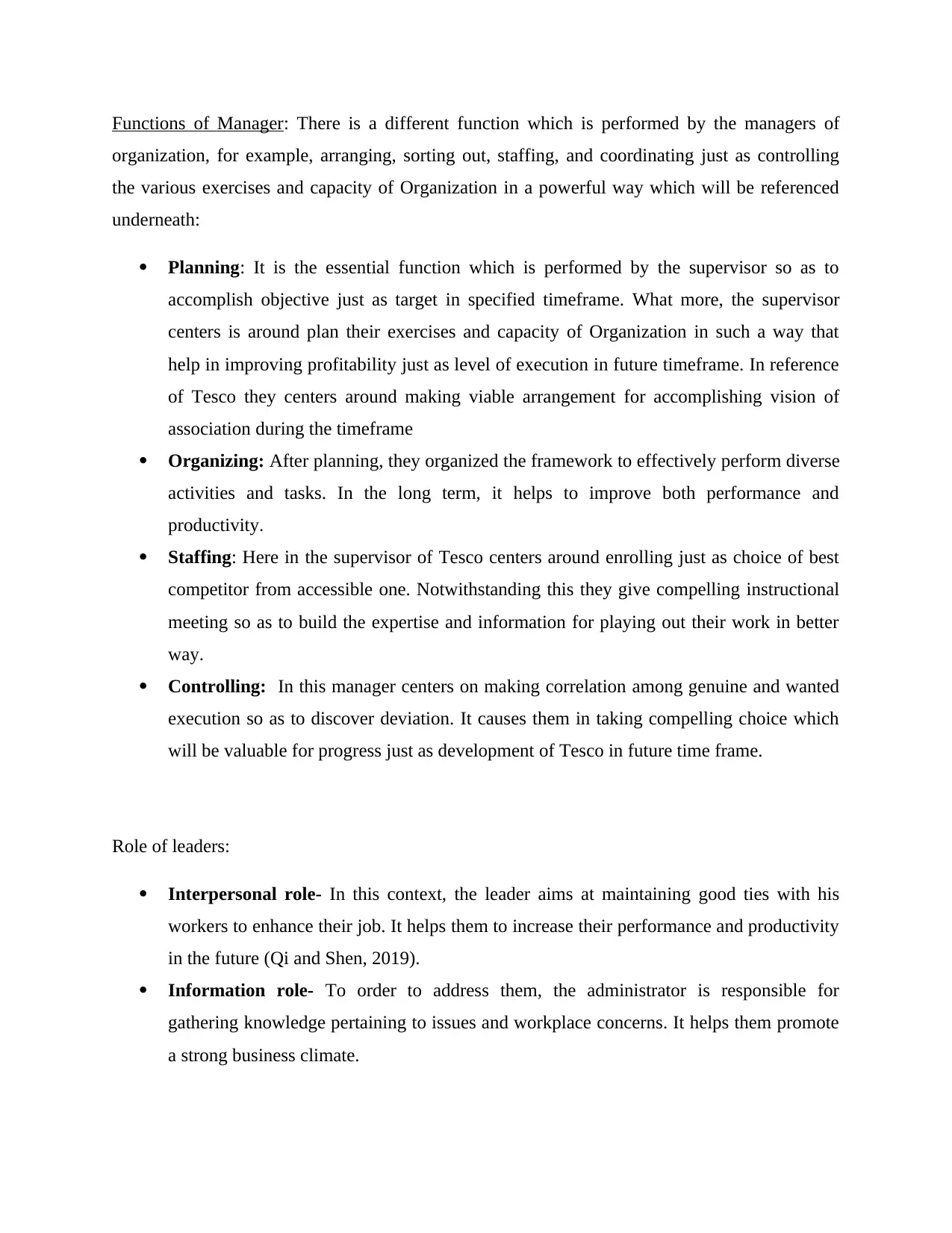
Functions of Manager: There is a different function which is performed by the managers of
organization, for example, arranging, sorting out, staffing, and coordinating just as controlling
the various exercises and capacity of Organization in a powerful way which will be referenced
underneath:
Planning: It is the essential function which is performed by the supervisor so as to
accomplish objective just as target in specified timeframe. What more, the supervisor
centers is around plan their exercises and capacity of Organization in such a way that
help in improving profitability just as level of execution in future timeframe. In reference
of Tesco they centers around making viable arrangement for accomplishing vision of
association during the timeframe
Organizing: After planning, they organized the framework to effectively perform diverse
activities and tasks. In the long term, it helps to improve both performance and
productivity.
Staffing: Here in the supervisor of Tesco centers around enrolling just as choice of best
competitor from accessible one. Notwithstanding this they give compelling instructional
meeting so as to build the expertise and information for playing out their work in better
way.
Controlling: In this manager centers on making correlation among genuine and wanted
execution so as to discover deviation. It causes them in taking compelling choice which
will be valuable for progress just as development of Tesco in future time frame.
Role of leaders:
Interpersonal role- In this context, the leader aims at maintaining good ties with his
workers to enhance their job. It helps them to increase their performance and productivity
in the future (Qi and Shen, 2019).
Information role- To order to address them, the administrator is responsible for
gathering knowledge pertaining to issues and workplace concerns. It helps them promote
a strong business climate.
organization, for example, arranging, sorting out, staffing, and coordinating just as controlling
the various exercises and capacity of Organization in a powerful way which will be referenced
underneath:
Planning: It is the essential function which is performed by the supervisor so as to
accomplish objective just as target in specified timeframe. What more, the supervisor
centers is around plan their exercises and capacity of Organization in such a way that
help in improving profitability just as level of execution in future timeframe. In reference
of Tesco they centers around making viable arrangement for accomplishing vision of
association during the timeframe
Organizing: After planning, they organized the framework to effectively perform diverse
activities and tasks. In the long term, it helps to improve both performance and
productivity.
Staffing: Here in the supervisor of Tesco centers around enrolling just as choice of best
competitor from accessible one. Notwithstanding this they give compelling instructional
meeting so as to build the expertise and information for playing out their work in better
way.
Controlling: In this manager centers on making correlation among genuine and wanted
execution so as to discover deviation. It causes them in taking compelling choice which
will be valuable for progress just as development of Tesco in future time frame.
Role of leaders:
Interpersonal role- In this context, the leader aims at maintaining good ties with his
workers to enhance their job. It helps them to increase their performance and productivity
in the future (Qi and Shen, 2019).
Information role- To order to address them, the administrator is responsible for
gathering knowledge pertaining to issues and workplace concerns. It helps them promote
a strong business climate.
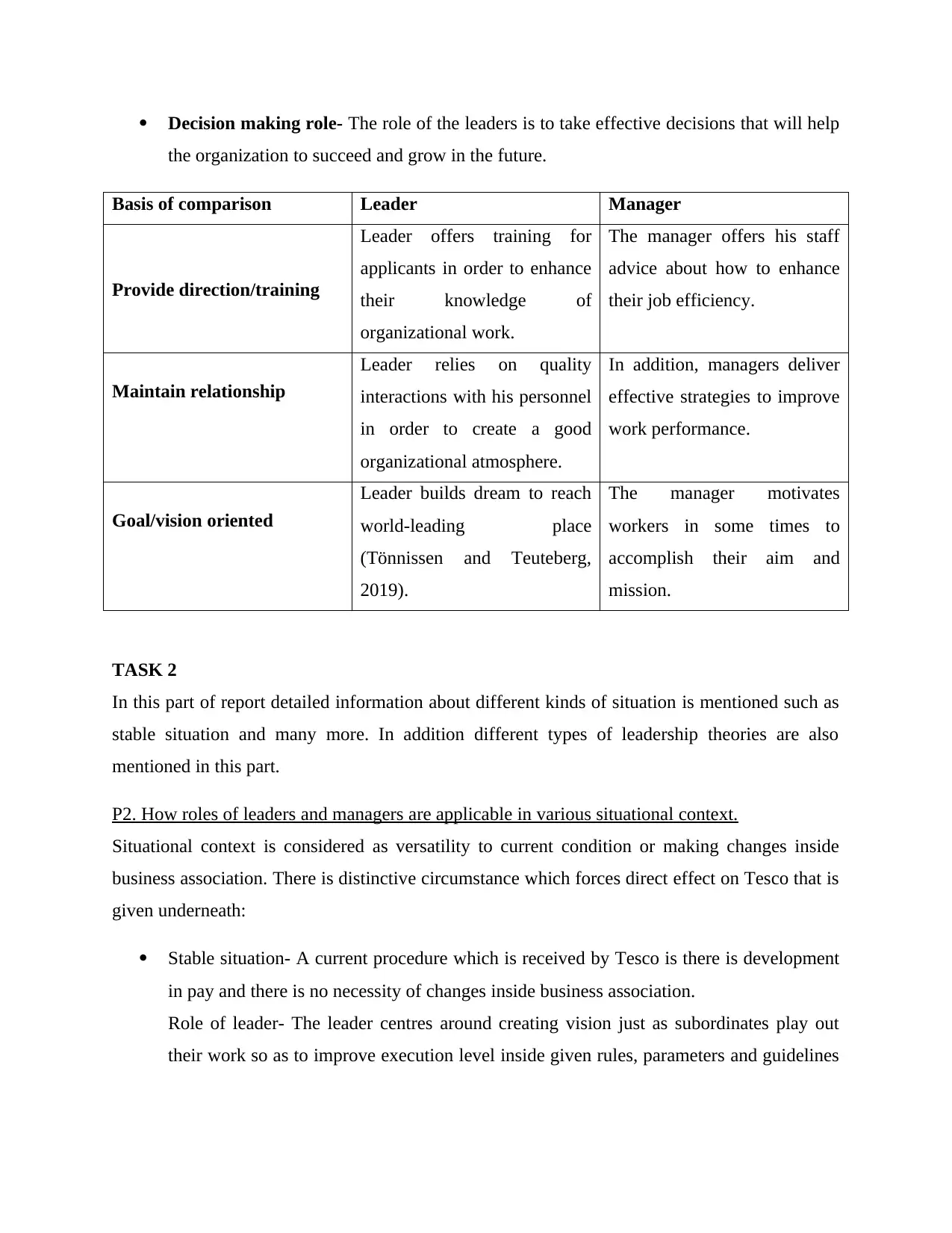
Decision making role- The role of the leaders is to take effective decisions that will help
the organization to succeed and grow in the future.
Basis of comparison Leader Manager
Provide direction/training
Leader offers training for
applicants in order to enhance
their knowledge of
organizational work.
The manager offers his staff
advice about how to enhance
their job efficiency.
Maintain relationship
Leader relies on quality
interactions with his personnel
in order to create a good
organizational atmosphere.
In addition, managers deliver
effective strategies to improve
work performance.
Goal/vision oriented
Leader builds dream to reach
world-leading place
(Tönnissen and Teuteberg,
2019).
The manager motivates
workers in some times to
accomplish their aim and
mission.
TASK 2
In this part of report detailed information about different kinds of situation is mentioned such as
stable situation and many more. In addition different types of leadership theories are also
mentioned in this part.
P2. How roles of leaders and managers are applicable in various situational context.
Situational context is considered as versatility to current condition or making changes inside
business association. There is distinctive circumstance which forces direct effect on Tesco that is
given underneath:
Stable situation- A current procedure which is received by Tesco is there is development
in pay and there is no necessity of changes inside business association.
Role of leader- The leader centres around creating vision just as subordinates play out
their work so as to improve execution level inside given rules, parameters and guidelines
the organization to succeed and grow in the future.
Basis of comparison Leader Manager
Provide direction/training
Leader offers training for
applicants in order to enhance
their knowledge of
organizational work.
The manager offers his staff
advice about how to enhance
their job efficiency.
Maintain relationship
Leader relies on quality
interactions with his personnel
in order to create a good
organizational atmosphere.
In addition, managers deliver
effective strategies to improve
work performance.
Goal/vision oriented
Leader builds dream to reach
world-leading place
(Tönnissen and Teuteberg,
2019).
The manager motivates
workers in some times to
accomplish their aim and
mission.
TASK 2
In this part of report detailed information about different kinds of situation is mentioned such as
stable situation and many more. In addition different types of leadership theories are also
mentioned in this part.
P2. How roles of leaders and managers are applicable in various situational context.
Situational context is considered as versatility to current condition or making changes inside
business association. There is distinctive circumstance which forces direct effect on Tesco that is
given underneath:
Stable situation- A current procedure which is received by Tesco is there is development
in pay and there is no necessity of changes inside business association.
Role of leader- The leader centres around creating vision just as subordinates play out
their work so as to improve execution level inside given rules, parameters and guidelines
⊘ This is a preview!⊘
Do you want full access?
Subscribe today to unlock all pages.

Trusted by 1+ million students worldwide
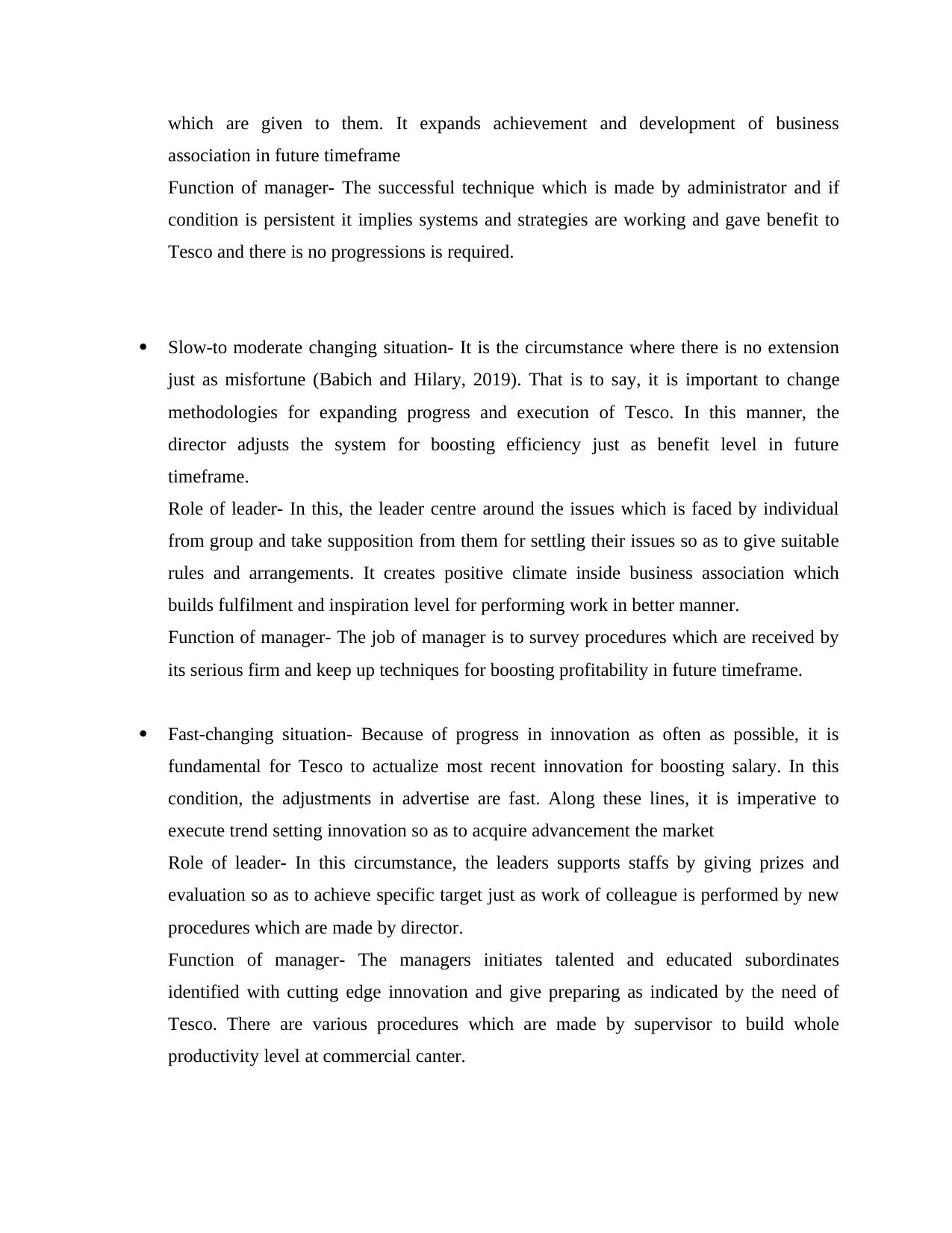
which are given to them. It expands achievement and development of business
association in future timeframe
Function of manager- The successful technique which is made by administrator and if
condition is persistent it implies systems and strategies are working and gave benefit to
Tesco and there is no progressions is required.
Slow-to moderate changing situation- It is the circumstance where there is no extension
just as misfortune (Babich and Hilary, 2019). That is to say, it is important to change
methodologies for expanding progress and execution of Tesco. In this manner, the
director adjusts the system for boosting efficiency just as benefit level in future
timeframe.
Role of leader- In this, the leader centre around the issues which is faced by individual
from group and take supposition from them for settling their issues so as to give suitable
rules and arrangements. It creates positive climate inside business association which
builds fulfilment and inspiration level for performing work in better manner.
Function of manager- The job of manager is to survey procedures which are received by
its serious firm and keep up techniques for boosting profitability in future timeframe.
Fast-changing situation- Because of progress in innovation as often as possible, it is
fundamental for Tesco to actualize most recent innovation for boosting salary. In this
condition, the adjustments in advertise are fast. Along these lines, it is imperative to
execute trend setting innovation so as to acquire advancement the market
Role of leader- In this circumstance, the leaders supports staffs by giving prizes and
evaluation so as to achieve specific target just as work of colleague is performed by new
procedures which are made by director.
Function of manager- The managers initiates talented and educated subordinates
identified with cutting edge innovation and give preparing as indicated by the need of
Tesco. There are various procedures which are made by supervisor to build whole
productivity level at commercial canter.
association in future timeframe
Function of manager- The successful technique which is made by administrator and if
condition is persistent it implies systems and strategies are working and gave benefit to
Tesco and there is no progressions is required.
Slow-to moderate changing situation- It is the circumstance where there is no extension
just as misfortune (Babich and Hilary, 2019). That is to say, it is important to change
methodologies for expanding progress and execution of Tesco. In this manner, the
director adjusts the system for boosting efficiency just as benefit level in future
timeframe.
Role of leader- In this, the leader centre around the issues which is faced by individual
from group and take supposition from them for settling their issues so as to give suitable
rules and arrangements. It creates positive climate inside business association which
builds fulfilment and inspiration level for performing work in better manner.
Function of manager- The job of manager is to survey procedures which are received by
its serious firm and keep up techniques for boosting profitability in future timeframe.
Fast-changing situation- Because of progress in innovation as often as possible, it is
fundamental for Tesco to actualize most recent innovation for boosting salary. In this
condition, the adjustments in advertise are fast. Along these lines, it is imperative to
execute trend setting innovation so as to acquire advancement the market
Role of leader- In this circumstance, the leaders supports staffs by giving prizes and
evaluation so as to achieve specific target just as work of colleague is performed by new
procedures which are made by director.
Function of manager- The managers initiates talented and educated subordinates
identified with cutting edge innovation and give preparing as indicated by the need of
Tesco. There are various procedures which are made by supervisor to build whole
productivity level at commercial canter.
Paraphrase This Document
Need a fresh take? Get an instant paraphrase of this document with our AI Paraphraser
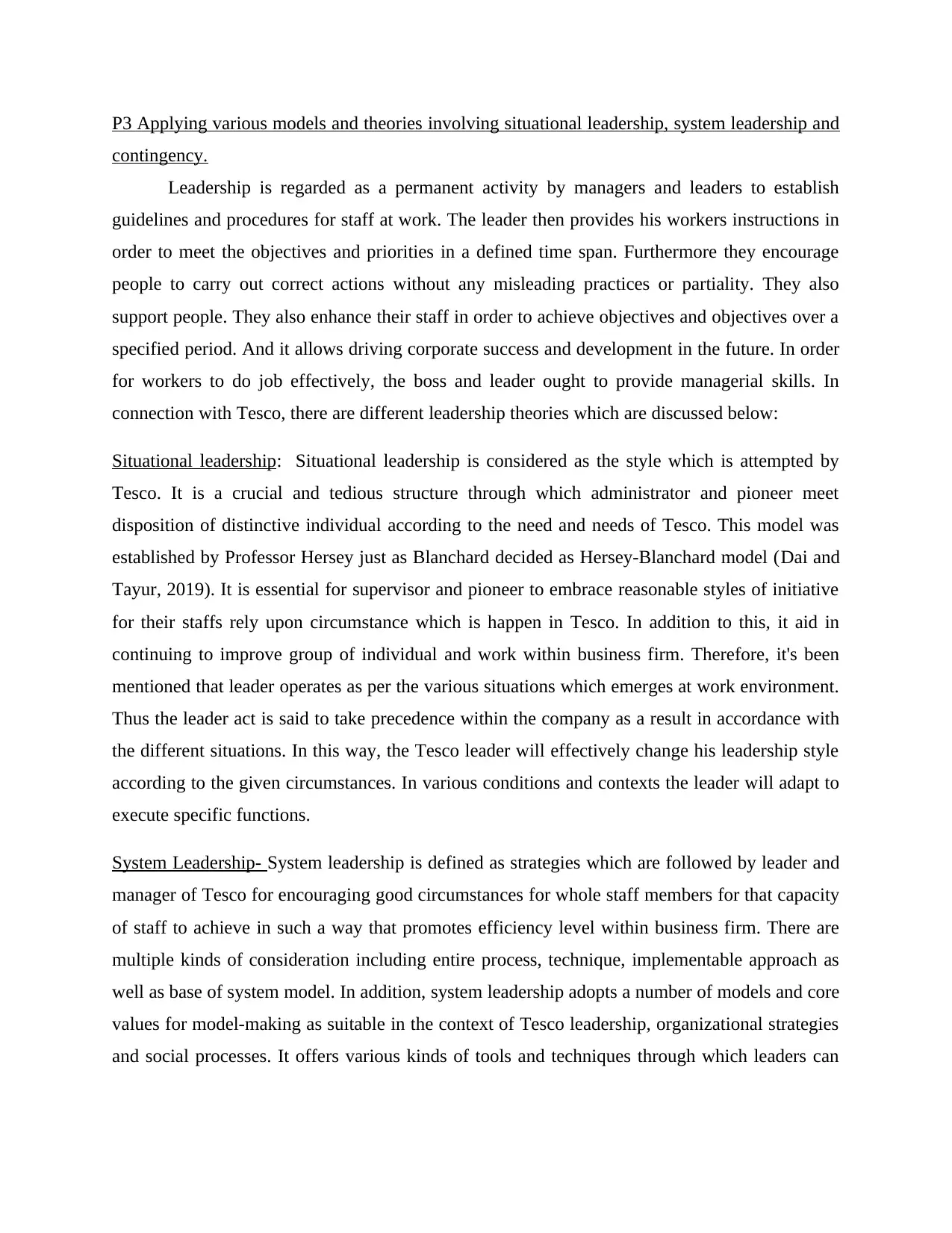
P3 Applying various models and theories involving situational leadership, system leadership and
contingency.
Leadership is regarded as a permanent activity by managers and leaders to establish
guidelines and procedures for staff at work. The leader then provides his workers instructions in
order to meet the objectives and priorities in a defined time span. Furthermore they encourage
people to carry out correct actions without any misleading practices or partiality. They also
support people. They also enhance their staff in order to achieve objectives and objectives over a
specified period. And it allows driving corporate success and development in the future. In order
for workers to do job effectively, the boss and leader ought to provide managerial skills. In
connection with Tesco, there are different leadership theories which are discussed below:
Situational leadership: Situational leadership is considered as the style which is attempted by
Tesco. It is a crucial and tedious structure through which administrator and pioneer meet
disposition of distinctive individual according to the need and needs of Tesco. This model was
established by Professor Hersey just as Blanchard decided as Hersey-Blanchard model (Dai and
Tayur, 2019). It is essential for supervisor and pioneer to embrace reasonable styles of initiative
for their staffs rely upon circumstance which is happen in Tesco. In addition to this, it aid in
continuing to improve group of individual and work within business firm. Therefore, it's been
mentioned that leader operates as per the various situations which emerges at work environment.
Thus the leader act is said to take precedence within the company as a result in accordance with
the different situations. In this way, the Tesco leader will effectively change his leadership style
according to the given circumstances. In various conditions and contexts the leader will adapt to
execute specific functions.
System Leadership- System leadership is defined as strategies which are followed by leader and
manager of Tesco for encouraging good circumstances for whole staff members for that capacity
of staff to achieve in such a way that promotes efficiency level within business firm. There are
multiple kinds of consideration including entire process, technique, implementable approach as
well as base of system model. In addition, system leadership adopts a number of models and core
values for model-making as suitable in the context of Tesco leadership, organizational strategies
and social processes. It offers various kinds of tools and techniques through which leaders can
contingency.
Leadership is regarded as a permanent activity by managers and leaders to establish
guidelines and procedures for staff at work. The leader then provides his workers instructions in
order to meet the objectives and priorities in a defined time span. Furthermore they encourage
people to carry out correct actions without any misleading practices or partiality. They also
support people. They also enhance their staff in order to achieve objectives and objectives over a
specified period. And it allows driving corporate success and development in the future. In order
for workers to do job effectively, the boss and leader ought to provide managerial skills. In
connection with Tesco, there are different leadership theories which are discussed below:
Situational leadership: Situational leadership is considered as the style which is attempted by
Tesco. It is a crucial and tedious structure through which administrator and pioneer meet
disposition of distinctive individual according to the need and needs of Tesco. This model was
established by Professor Hersey just as Blanchard decided as Hersey-Blanchard model (Dai and
Tayur, 2019). It is essential for supervisor and pioneer to embrace reasonable styles of initiative
for their staffs rely upon circumstance which is happen in Tesco. In addition to this, it aid in
continuing to improve group of individual and work within business firm. Therefore, it's been
mentioned that leader operates as per the various situations which emerges at work environment.
Thus the leader act is said to take precedence within the company as a result in accordance with
the different situations. In this way, the Tesco leader will effectively change his leadership style
according to the given circumstances. In various conditions and contexts the leader will adapt to
execute specific functions.
System Leadership- System leadership is defined as strategies which are followed by leader and
manager of Tesco for encouraging good circumstances for whole staff members for that capacity
of staff to achieve in such a way that promotes efficiency level within business firm. There are
multiple kinds of consideration including entire process, technique, implementable approach as
well as base of system model. In addition, system leadership adopts a number of models and core
values for model-making as suitable in the context of Tesco leadership, organizational strategies
and social processes. It offers various kinds of tools and techniques through which leaders can
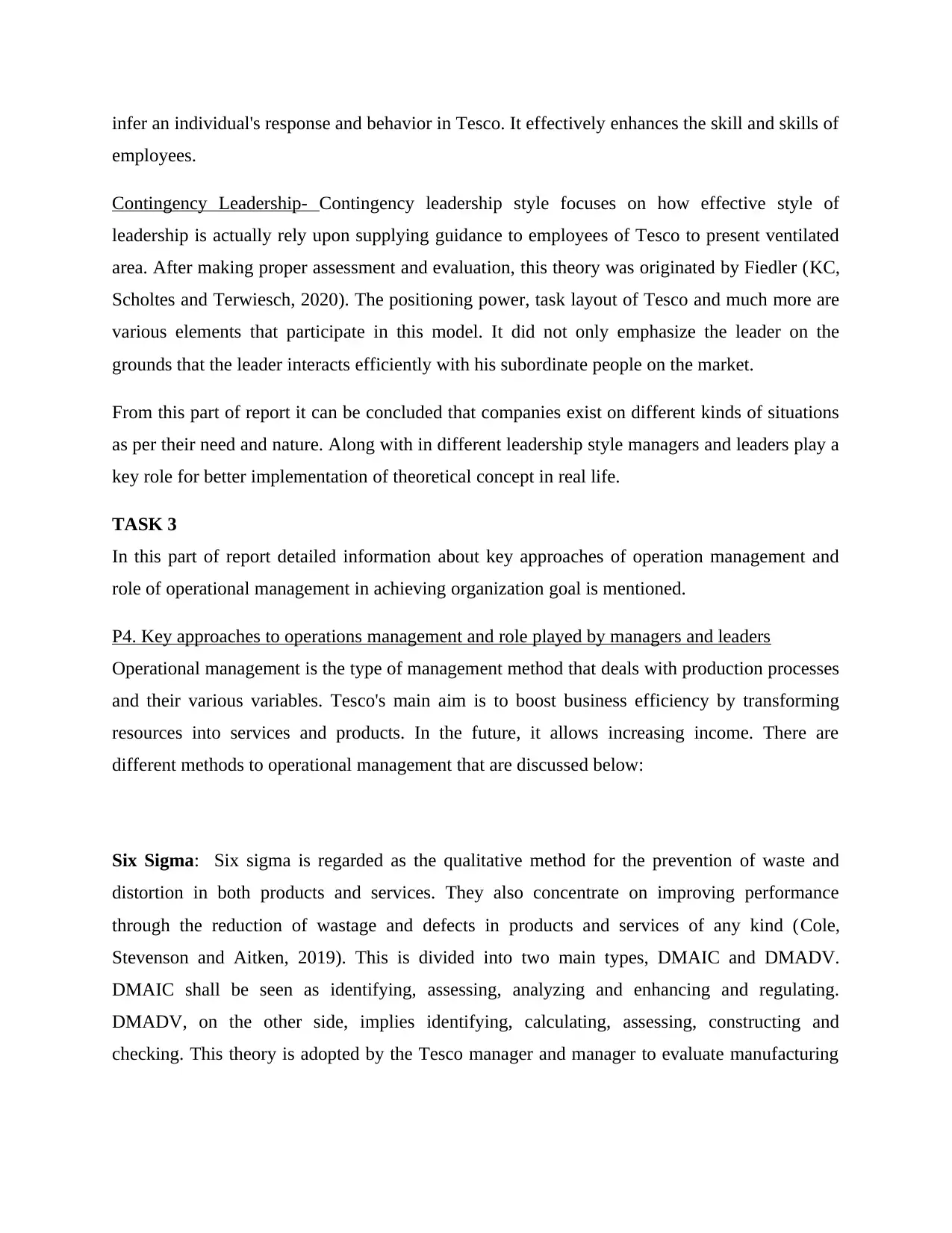
infer an individual's response and behavior in Tesco. It effectively enhances the skill and skills of
employees.
Contingency Leadership- Contingency leadership style focuses on how effective style of
leadership is actually rely upon supplying guidance to employees of Tesco to present ventilated
area. After making proper assessment and evaluation, this theory was originated by Fiedler (KC,
Scholtes and Terwiesch, 2020). The positioning power, task layout of Tesco and much more are
various elements that participate in this model. It did not only emphasize the leader on the
grounds that the leader interacts efficiently with his subordinate people on the market.
From this part of report it can be concluded that companies exist on different kinds of situations
as per their need and nature. Along with in different leadership style managers and leaders play a
key role for better implementation of theoretical concept in real life.
TASK 3
In this part of report detailed information about key approaches of operation management and
role of operational management in achieving organization goal is mentioned.
P4. Key approaches to operations management and role played by managers and leaders
Operational management is the type of management method that deals with production processes
and their various variables. Tesco's main aim is to boost business efficiency by transforming
resources into services and products. In the future, it allows increasing income. There are
different methods to operational management that are discussed below:
Six Sigma: Six sigma is regarded as the qualitative method for the prevention of waste and
distortion in both products and services. They also concentrate on improving performance
through the reduction of wastage and defects in products and services of any kind (Cole,
Stevenson and Aitken, 2019). This is divided into two main types, DMAIC and DMADV.
DMAIC shall be seen as identifying, assessing, analyzing and enhancing and regulating.
DMADV, on the other side, implies identifying, calculating, assessing, constructing and
checking. This theory is adopted by the Tesco manager and manager to evaluate manufacturing
employees.
Contingency Leadership- Contingency leadership style focuses on how effective style of
leadership is actually rely upon supplying guidance to employees of Tesco to present ventilated
area. After making proper assessment and evaluation, this theory was originated by Fiedler (KC,
Scholtes and Terwiesch, 2020). The positioning power, task layout of Tesco and much more are
various elements that participate in this model. It did not only emphasize the leader on the
grounds that the leader interacts efficiently with his subordinate people on the market.
From this part of report it can be concluded that companies exist on different kinds of situations
as per their need and nature. Along with in different leadership style managers and leaders play a
key role for better implementation of theoretical concept in real life.
TASK 3
In this part of report detailed information about key approaches of operation management and
role of operational management in achieving organization goal is mentioned.
P4. Key approaches to operations management and role played by managers and leaders
Operational management is the type of management method that deals with production processes
and their various variables. Tesco's main aim is to boost business efficiency by transforming
resources into services and products. In the future, it allows increasing income. There are
different methods to operational management that are discussed below:
Six Sigma: Six sigma is regarded as the qualitative method for the prevention of waste and
distortion in both products and services. They also concentrate on improving performance
through the reduction of wastage and defects in products and services of any kind (Cole,
Stevenson and Aitken, 2019). This is divided into two main types, DMAIC and DMADV.
DMAIC shall be seen as identifying, assessing, analyzing and enhancing and regulating.
DMADV, on the other side, implies identifying, calculating, assessing, constructing and
checking. This theory is adopted by the Tesco manager and manager to evaluate manufacturing
⊘ This is a preview!⊘
Do you want full access?
Subscribe today to unlock all pages.

Trusted by 1+ million students worldwide
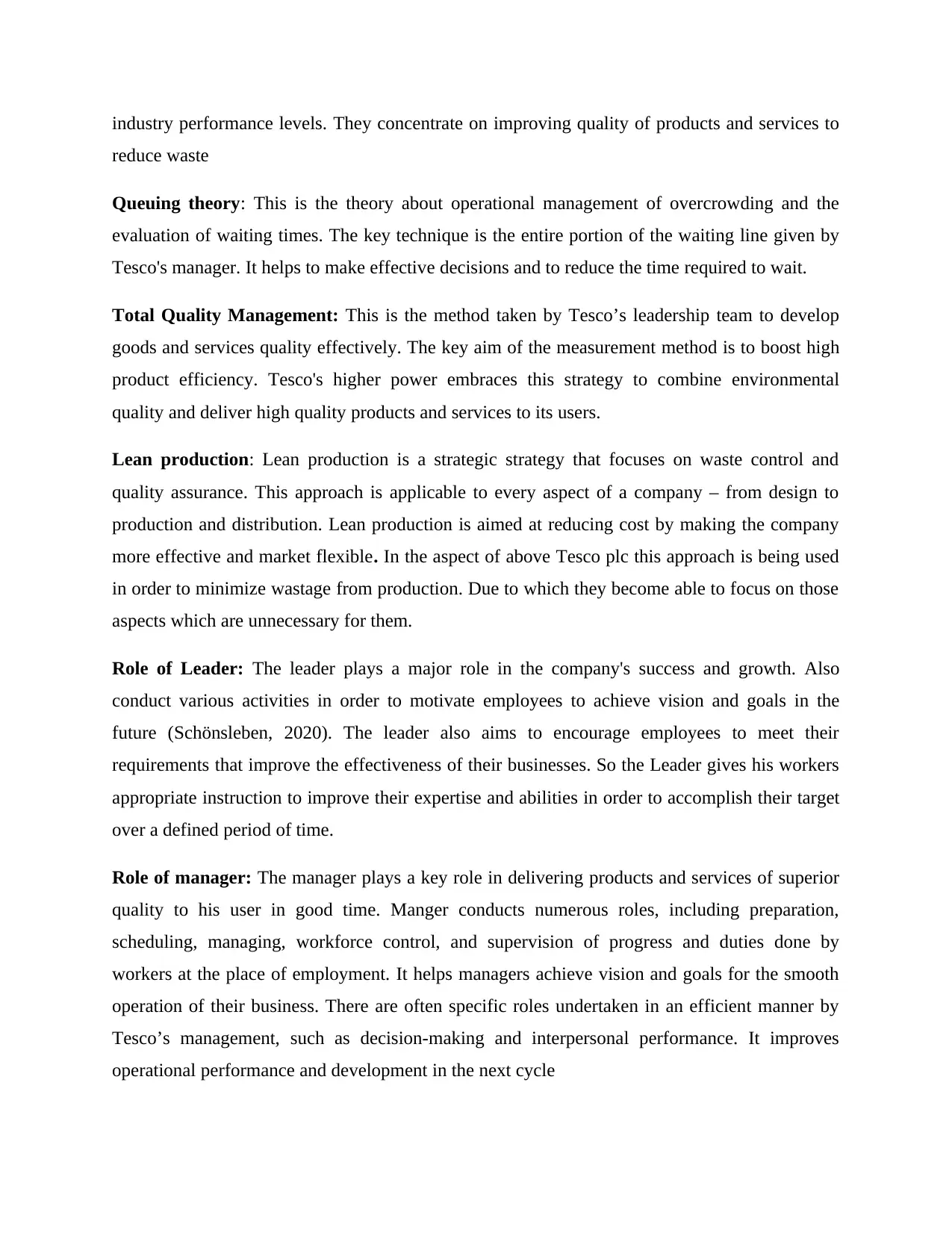
industry performance levels. They concentrate on improving quality of products and services to
reduce waste
Queuing theory: This is the theory about operational management of overcrowding and the
evaluation of waiting times. The key technique is the entire portion of the waiting line given by
Tesco's manager. It helps to make effective decisions and to reduce the time required to wait.
Total Quality Management: This is the method taken by Tesco’s leadership team to develop
goods and services quality effectively. The key aim of the measurement method is to boost high
product efficiency. Tesco's higher power embraces this strategy to combine environmental
quality and deliver high quality products and services to its users.
Lean production: Lean production is a strategic strategy that focuses on waste control and
quality assurance. This approach is applicable to every aspect of a company – from design to
production and distribution. Lean production is aimed at reducing cost by making the company
more effective and market flexible. In the aspect of above Tesco plc this approach is being used
in order to minimize wastage from production. Due to which they become able to focus on those
aspects which are unnecessary for them.
Role of Leader: The leader plays a major role in the company's success and growth. Also
conduct various activities in order to motivate employees to achieve vision and goals in the
future (Schönsleben, 2020). The leader also aims to encourage employees to meet their
requirements that improve the effectiveness of their businesses. So the Leader gives his workers
appropriate instruction to improve their expertise and abilities in order to accomplish their target
over a defined period of time.
Role of manager: The manager plays a key role in delivering products and services of superior
quality to his user in good time. Manger conducts numerous roles, including preparation,
scheduling, managing, workforce control, and supervision of progress and duties done by
workers at the place of employment. It helps managers achieve vision and goals for the smooth
operation of their business. There are often specific roles undertaken in an efficient manner by
Tesco’s management, such as decision-making and interpersonal performance. It improves
operational performance and development in the next cycle
reduce waste
Queuing theory: This is the theory about operational management of overcrowding and the
evaluation of waiting times. The key technique is the entire portion of the waiting line given by
Tesco's manager. It helps to make effective decisions and to reduce the time required to wait.
Total Quality Management: This is the method taken by Tesco’s leadership team to develop
goods and services quality effectively. The key aim of the measurement method is to boost high
product efficiency. Tesco's higher power embraces this strategy to combine environmental
quality and deliver high quality products and services to its users.
Lean production: Lean production is a strategic strategy that focuses on waste control and
quality assurance. This approach is applicable to every aspect of a company – from design to
production and distribution. Lean production is aimed at reducing cost by making the company
more effective and market flexible. In the aspect of above Tesco plc this approach is being used
in order to minimize wastage from production. Due to which they become able to focus on those
aspects which are unnecessary for them.
Role of Leader: The leader plays a major role in the company's success and growth. Also
conduct various activities in order to motivate employees to achieve vision and goals in the
future (Schönsleben, 2020). The leader also aims to encourage employees to meet their
requirements that improve the effectiveness of their businesses. So the Leader gives his workers
appropriate instruction to improve their expertise and abilities in order to accomplish their target
over a defined period of time.
Role of manager: The manager plays a key role in delivering products and services of superior
quality to his user in good time. Manger conducts numerous roles, including preparation,
scheduling, managing, workforce control, and supervision of progress and duties done by
workers at the place of employment. It helps managers achieve vision and goals for the smooth
operation of their business. There are often specific roles undertaken in an efficient manner by
Tesco’s management, such as decision-making and interpersonal performance. It improves
operational performance and development in the next cycle
Paraphrase This Document
Need a fresh take? Get an instant paraphrase of this document with our AI Paraphraser
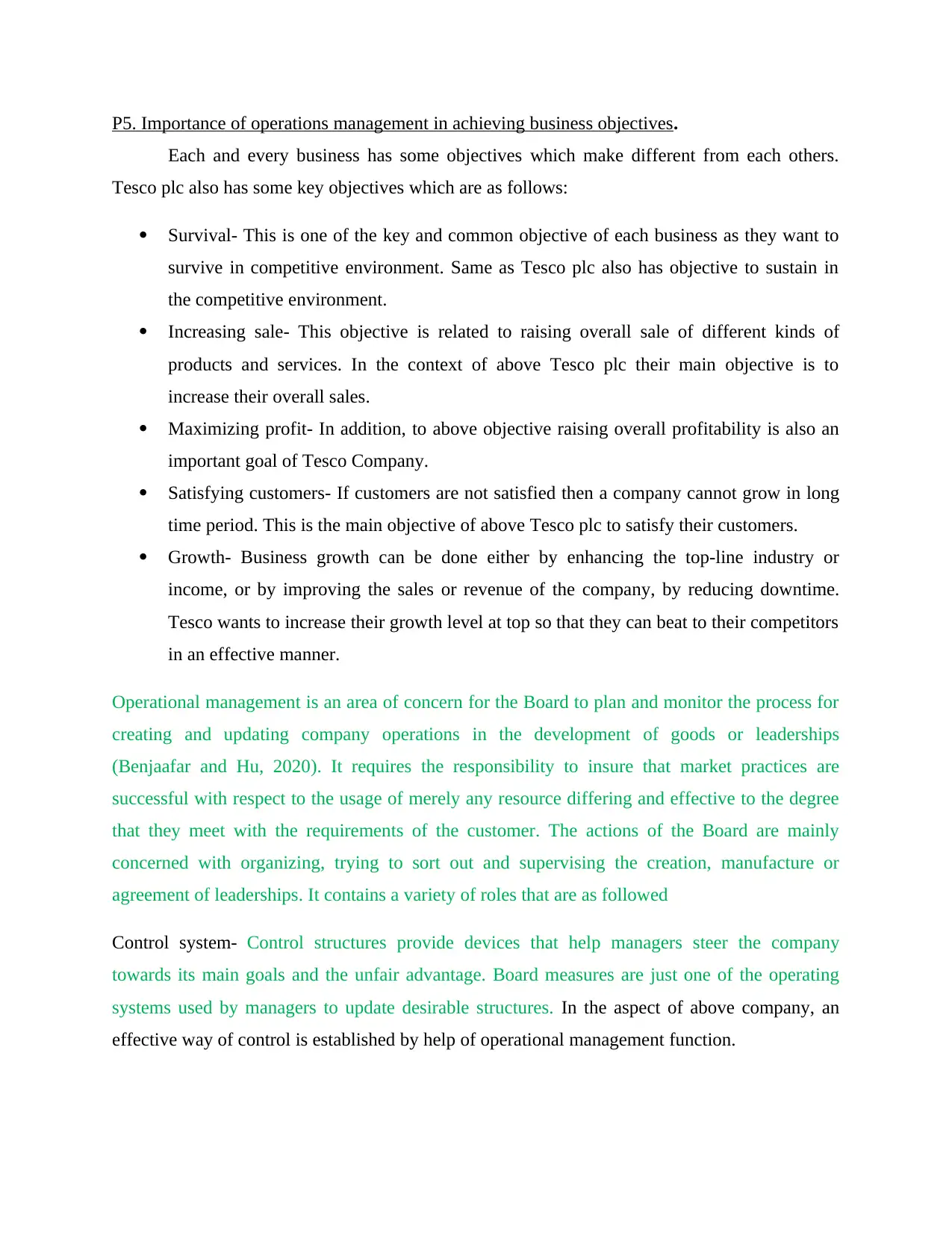
P5. Importance of operations management in achieving business objectives.
Each and every business has some objectives which make different from each others.
Tesco plc also has some key objectives which are as follows:
Survival- This is one of the key and common objective of each business as they want to
survive in competitive environment. Same as Tesco plc also has objective to sustain in
the competitive environment.
Increasing sale- This objective is related to raising overall sale of different kinds of
products and services. In the context of above Tesco plc their main objective is to
increase their overall sales.
Maximizing profit- In addition, to above objective raising overall profitability is also an
important goal of Tesco Company.
Satisfying customers- If customers are not satisfied then a company cannot grow in long
time period. This is the main objective of above Tesco plc to satisfy their customers.
Growth- Business growth can be done either by enhancing the top-line industry or
income, or by improving the sales or revenue of the company, by reducing downtime.
Tesco wants to increase their growth level at top so that they can beat to their competitors
in an effective manner.
Operational management is an area of concern for the Board to plan and monitor the process for
creating and updating company operations in the development of goods or leaderships
(Benjaafar and Hu, 2020). It requires the responsibility to insure that market practices are
successful with respect to the usage of merely any resource differing and effective to the degree
that they meet with the requirements of the customer. The actions of the Board are mainly
concerned with organizing, trying to sort out and supervising the creation, manufacture or
agreement of leaderships. It contains a variety of roles that are as followed
Control system- Control structures provide devices that help managers steer the company
towards its main goals and the unfair advantage. Board measures are just one of the operating
systems used by managers to update desirable structures. In the aspect of above company, an
effective way of control is established by help of operational management function.
Each and every business has some objectives which make different from each others.
Tesco plc also has some key objectives which are as follows:
Survival- This is one of the key and common objective of each business as they want to
survive in competitive environment. Same as Tesco plc also has objective to sustain in
the competitive environment.
Increasing sale- This objective is related to raising overall sale of different kinds of
products and services. In the context of above Tesco plc their main objective is to
increase their overall sales.
Maximizing profit- In addition, to above objective raising overall profitability is also an
important goal of Tesco Company.
Satisfying customers- If customers are not satisfied then a company cannot grow in long
time period. This is the main objective of above Tesco plc to satisfy their customers.
Growth- Business growth can be done either by enhancing the top-line industry or
income, or by improving the sales or revenue of the company, by reducing downtime.
Tesco wants to increase their growth level at top so that they can beat to their competitors
in an effective manner.
Operational management is an area of concern for the Board to plan and monitor the process for
creating and updating company operations in the development of goods or leaderships
(Benjaafar and Hu, 2020). It requires the responsibility to insure that market practices are
successful with respect to the usage of merely any resource differing and effective to the degree
that they meet with the requirements of the customer. The actions of the Board are mainly
concerned with organizing, trying to sort out and supervising the creation, manufacture or
agreement of leaderships. It contains a variety of roles that are as followed
Control system- Control structures provide devices that help managers steer the company
towards its main goals and the unfair advantage. Board measures are just one of the operating
systems used by managers to update desirable structures. In the aspect of above company, an
effective way of control is established by help of operational management function.
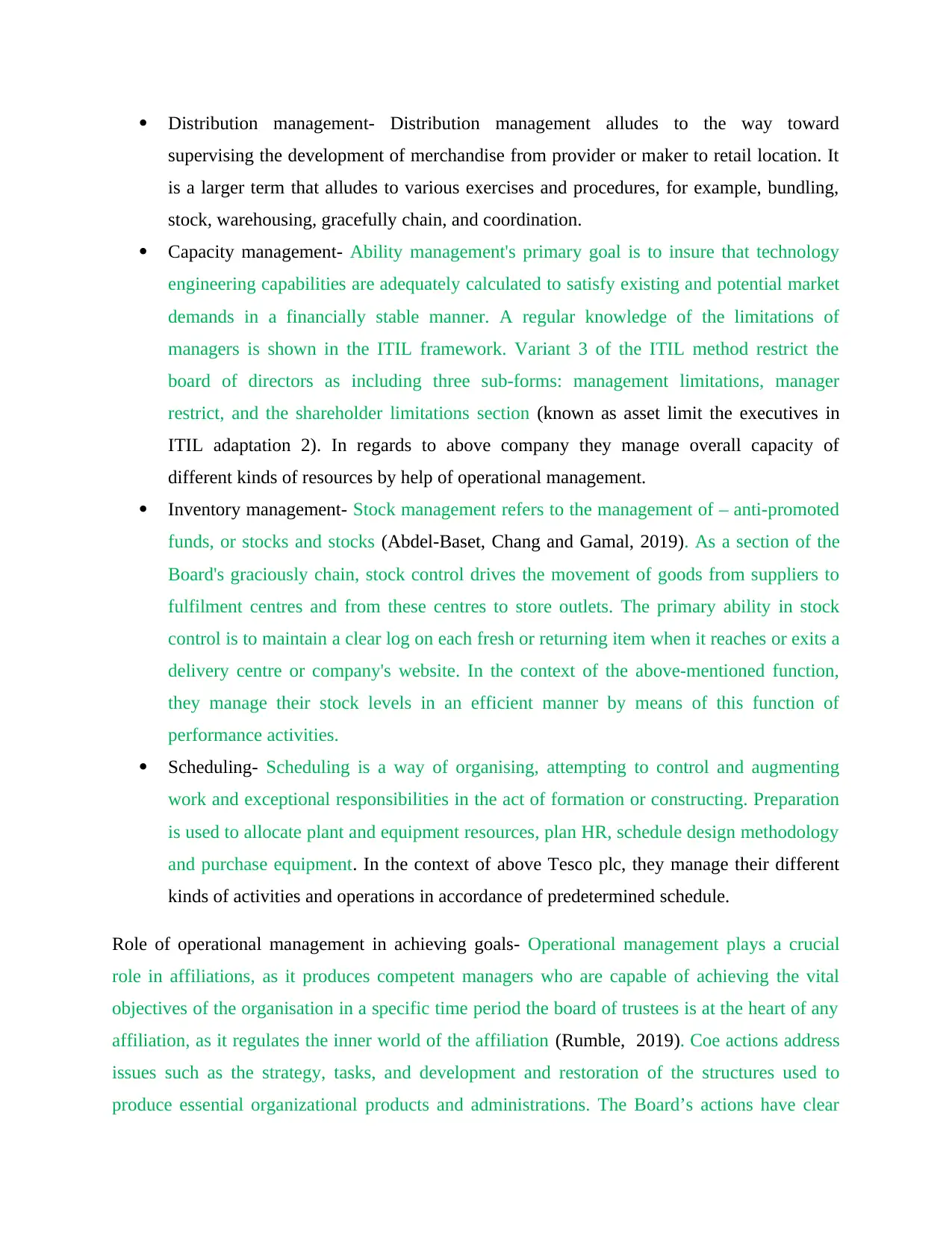
Distribution management- Distribution management alludes to the way toward
supervising the development of merchandise from provider or maker to retail location. It
is a larger term that alludes to various exercises and procedures, for example, bundling,
stock, warehousing, gracefully chain, and coordination.
Capacity management- Ability management's primary goal is to insure that technology
engineering capabilities are adequately calculated to satisfy existing and potential market
demands in a financially stable manner. A regular knowledge of the limitations of
managers is shown in the ITIL framework. Variant 3 of the ITIL method restrict the
board of directors as including three sub-forms: management limitations, manager
restrict, and the shareholder limitations section (known as asset limit the executives in
ITIL adaptation 2). In regards to above company they manage overall capacity of
different kinds of resources by help of operational management.
Inventory management- Stock management refers to the management of – anti-promoted
funds, or stocks and stocks (Abdel-Baset, Chang and Gamal, 2019). As a section of the
Board's graciously chain, stock control drives the movement of goods from suppliers to
fulfilment centres and from these centres to store outlets. The primary ability in stock
control is to maintain a clear log on each fresh or returning item when it reaches or exits a
delivery centre or company's website. In the context of the above-mentioned function,
they manage their stock levels in an efficient manner by means of this function of
performance activities.
Scheduling- Scheduling is a way of organising, attempting to control and augmenting
work and exceptional responsibilities in the act of formation or constructing. Preparation
is used to allocate plant and equipment resources, plan HR, schedule design methodology
and purchase equipment. In the context of above Tesco plc, they manage their different
kinds of activities and operations in accordance of predetermined schedule.
Role of operational management in achieving goals- Operational management plays a crucial
role in affiliations, as it produces competent managers who are capable of achieving the vital
objectives of the organisation in a specific time period the board of trustees is at the heart of any
affiliation, as it regulates the inner world of the affiliation (Rumble, 2019). Coe actions address
issues such as the strategy, tasks, and development and restoration of the structures used to
produce essential organizational products and administrations. The Board’s actions have clear
supervising the development of merchandise from provider or maker to retail location. It
is a larger term that alludes to various exercises and procedures, for example, bundling,
stock, warehousing, gracefully chain, and coordination.
Capacity management- Ability management's primary goal is to insure that technology
engineering capabilities are adequately calculated to satisfy existing and potential market
demands in a financially stable manner. A regular knowledge of the limitations of
managers is shown in the ITIL framework. Variant 3 of the ITIL method restrict the
board of directors as including three sub-forms: management limitations, manager
restrict, and the shareholder limitations section (known as asset limit the executives in
ITIL adaptation 2). In regards to above company they manage overall capacity of
different kinds of resources by help of operational management.
Inventory management- Stock management refers to the management of – anti-promoted
funds, or stocks and stocks (Abdel-Baset, Chang and Gamal, 2019). As a section of the
Board's graciously chain, stock control drives the movement of goods from suppliers to
fulfilment centres and from these centres to store outlets. The primary ability in stock
control is to maintain a clear log on each fresh or returning item when it reaches or exits a
delivery centre or company's website. In the context of the above-mentioned function,
they manage their stock levels in an efficient manner by means of this function of
performance activities.
Scheduling- Scheduling is a way of organising, attempting to control and augmenting
work and exceptional responsibilities in the act of formation or constructing. Preparation
is used to allocate plant and equipment resources, plan HR, schedule design methodology
and purchase equipment. In the context of above Tesco plc, they manage their different
kinds of activities and operations in accordance of predetermined schedule.
Role of operational management in achieving goals- Operational management plays a crucial
role in affiliations, as it produces competent managers who are capable of achieving the vital
objectives of the organisation in a specific time period the board of trustees is at the heart of any
affiliation, as it regulates the inner world of the affiliation (Rumble, 2019). Coe actions address
issues such as the strategy, tasks, and development and restoration of the structures used to
produce essential organizational products and administrations. The Board’s actions have clear
⊘ This is a preview!⊘
Do you want full access?
Subscribe today to unlock all pages.

Trusted by 1+ million students worldwide
1 out of 18
Related Documents
Your All-in-One AI-Powered Toolkit for Academic Success.
+13062052269
info@desklib.com
Available 24*7 on WhatsApp / Email
![[object Object]](/_next/static/media/star-bottom.7253800d.svg)
Unlock your academic potential
Copyright © 2020–2025 A2Z Services. All Rights Reserved. Developed and managed by ZUCOL.





